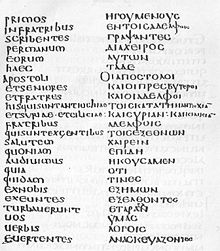- Codex Laudianus
-
New Testament manuscripts
papyri • uncials • minuscules • lectionariesUncial 08
Page from Codex Laudianus (Acts 15:22-24)Name Laudianus Sign Ea Text Book of Acts Date c. 550 Script Latin - Greek diglot Now at Bodleian Library, Oxford Size 27 cm by 22 cm Type Western text-type Category II Note It contains Acts 8:37 Codex Laudianus, designated by Ea or 08 (in the Gregory-Aland numbering), α 1001 (von Soden), called Laudianus after the former owner, Archbishop William Laud. It is a diglot Latin — Greek uncial manuscript of the New Testament, palaeographically assigned to the 6th century. It contains the Acts of the Apostles.
Contents
Description
It is diglot manuscript with Greek and Latin in parallel columns on the same page, but Latin is in the left-hand column. The codex contains 227 parchment leaves (size 27 cm by 22 cm), with almost complete text of the Book of Acts (lacuna in 26:29-28:26). It is the earliest known manuscript which contain text of Acts 8:37.
The text is written in two columns per page, 24 and more lines per page.[1] It is arranged in very short lines of only one to three words each.[2] The text is written colometrically. It is the earliest known manuscript that contains Acts 8:37.[2]
Text
The Greek text of this codex exhibits a mixture of text-types, usually the Byzantine, but there are many Western and some Alexandrian readings. According to Kurt Aland it agrees with the Byzantine text-type 36 times, and 21 times with the Byzantine when it has the same reading as the original text. It agrees 22 times with the original text against the Byzantine. It has 22 independent or distinctive readings. Aland placed it in Category II.[1]
It contains Acts 8:37, as do the manuscripts 323, 453, 945, 1739, 1891, 2818, and several others.[3]
In Acts 12:25 the Latin text of the codex reads from Jerusalem to Antioch – 429, 945, 1739, p, syrp, copsa geo; majority reads εις Ιερουσαλημ (to Jerusalem);[4]
In Acts 16:10 it reads θεος along with P74, Sinaiticus, Alexandrinus, Vaticanus, Ephraemi, 044, 33, 81, 181, 326, 630, 945, 1739, ar, e, l, vg, copbo, geo; other reading κυριος, is supported by D, P, 049, 056, 0142, 88, 104, 330, 436, 451, 614, 629, 1241, 1505, 1877, 2127, 2412, 2492, 2495, Byz, c, d, gig, syrp,h, copsa.[5]
In Acts 18:26 it reads την οδον του κυριου along with manuscripts 1505, 2495, and lectionary 598.[6]
In Acts 20:28 it reads του κυριου (of the Lord) along with the manuscripts: Papyrus 74, C*, D, Ψ, 33, 36, 453, 945, 1739, and 1891.[7][n 1]
History
It was probably written in Sardinia, during the Byzantine occupation, and therefore after 534 (terminus a quo). It was written before 716 (terminus ad quem), as it was used by Beda Venerabilis in his Expositio Actuum Apostolorum Retractata.
"It was brought to England probably by Theodore of Tarsus, Archbishop of Canterbury, in 668, or by Ceolfrid, Abbot of Wearmouth and Jarrow, in the early part of the eight century. It was probably deposited in one of the great monasteries in the north of England."[8]
It eventually came into the possession of William Laud, who donated to the Bodleian Library in Oxford in 1636, where it is located now (Cat. number: Laud. Gr. 35 1397, I,8).[9]
Thomas Hearne published its text in 1715, but not very exactly, then Hansell in 1864, and Constantin von Tischendorf in 1870.[10]
The manuscript was examined by Johann Jakob Griesbach, Ropes, Motzo, Poole, Clark, Lagrange, and Walther.
See also
Notes
- ^ For the another variants of this verse see: Textual variants in the Acts of the Apostles.
References
- ^ a b Aland, Kurt; Barbara Aland; Erroll F. Rhodes (trans.) (1995). The Text of the New Testament: An Introduction to the Critical Editions and to the Theory and Practice of Modern Textual Criticism. Grand Rapids: William B. Eerdmans Publishing Company. p. 110. ISBN 978-0-8028-4098-1. http://books.google.com/books?id=2pYDsAhUOxAC&printsec=frontcover&source=gbs_ge_summary_r&cad=0#v=onepage&q&f=false.
- ^ a b Metzger, Bruce M.; Ehrman, Bart D. (2005). The Text of the New Testament: Its Transmission, Corruption and Restoration (4 ed.). New York – Oxford: Oxford University Press. p. 74. ISBN 978-0-19-516122-9.
- ^ Nestle-Aland, Novum Testamentum Graece, 26th edition, p. 345; Bruce M. Metzger, A Textual Commentary on the Greek New Testament (Deutsche Bibelgesellschaft: Stuttgart 2001), p. 316.
- ^ UBS3, p. 464.
- ^ NA26, p. 480
- ^ UBS3, p. 491.
- ^ NA26, p. 384.
- ^ Frederic Kenyon, Our Bible and the ancient manuscripts (1939).
- ^ "Liste Handschriften". Münster: Institute for New Testament Textual Research. http://intf.uni-muenster.de/vmr/NTVMR/ListeHandschriften.php. Retrieved 8 March 2011.
- ^ C. R. Gregory, "Canon and Text of the New Testament" (T. & T. Clark: Edinburgh 1907), p. 363
Further reading
- C. v. Tischendorf, Monumenta sacra IX, (Leipzig, 1870).
- J. H. Ropes, The Greek Text of Codex Laudianus, Harvard Theological Review XVI (Cambridge, Mass., 1923), pp. 175-186.
- Samuel Berger, Un ancien texte latin des Actes des Apôtres retrouvé dans un manuscrit provenant de Perpignan (Paris 1895), pp. 11-12.
External links
- Manuscripts given by Archbishop William Laud (1573-1645)
- Codex Laudianus E (08): at the Encyclopedia of Textual Criticism
- Image from Codex Laudianus
- Image
- "Liste Handschriften". Münster: Institute for New Testament Textual Research. http://intf.uni-muenster.de/vmr/NTVMR/ListeHandschriften.php. Retrieved 8 March 2011.
Categories:- Greek New Testament uncials
- Old Latin New Testament manuscripts
- 6th-century biblical manuscripts
- Bodleian Library collection
Wikimedia Foundation. 2010.

